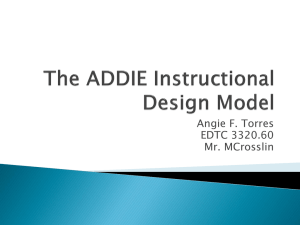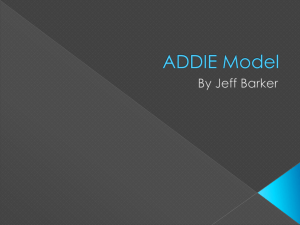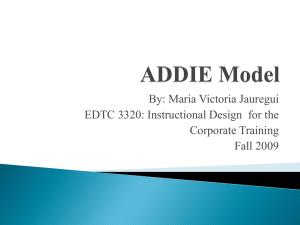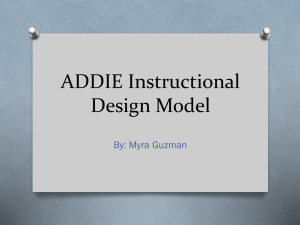ADDIE Process
advertisement
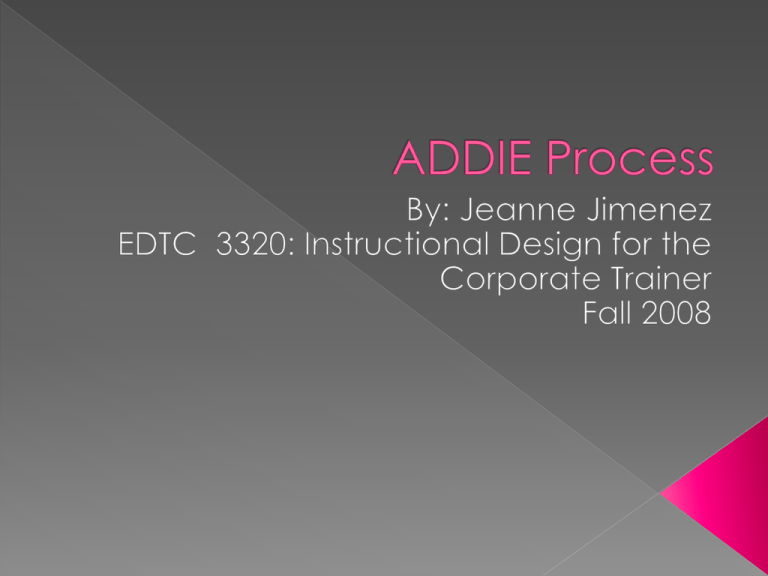
The ADDIE Process stands for Analysis, Design, Development, Implementation and Evaluation. Traditionally used by instructional designers as a step-by-step process in order to plan and create training programs. Florida State University developed the ADDIE model in 1975. It was selected by the Armed Services “as the primary means for developing training.” (Clark, 2004) During this time the term “ADDIE” wasn’t used instead it was called "ISD" (Instructional Systems Development) or “SAT” (Systems Approach to Training). (Clark, 2004) Clark, 2004 “Six years later, Dr. Russell Watson, Chief, Staff and Faculty Training Division of the Fort Huachuca, Arizona, presented a paper to International Congress for Individualized Instruction.”(Clark, 2004) In it, he discusses the U.S. Army's SAT model as developed by Florida State University. (Clark, 2004) Instead he used a model that had five basic phases that where still the same as FSU but the steps had been modified slightly Clark, 2004 Picture of the ADDIE Model now (Tufts University, 2007) In this phase, the problem is clarified. The goals and objectives are set and the learning environment as well as the knowledge and skills are identified. Questions that might be asked: › Who is the audience and what are their › › › › › characteristics? Identify the new behavioral outcome. What types of learning constraints exist? What are the delivery options? What are the online pedagogical considerations? What is the timeline for project completion? (ADDIE model) During this phase you deal with the learning objectives, content, subject matter analysis, and lesson planning, amongst other things. It should be systematic and specific. The steps used during the design phase: › Documentation of the project's instructional, visual › › › › and technical design strategy Apply instructional strategies according to the intended behavioral outcomes by domain (cognitive, affective, and psychomotor). Design the user interface and user experience Prototype creation Apply visual design (ADDIE model) Is the creation stage. Storyboards are created during this time Graphics are designed and content is written out. Select method of delivery (handouts, tapes, etc…) The project is reviewed and fixed based on feedback given. The plan is put into action and you are creating a procedure on how to train the learner. Project managers check to see if books, tools and hands on materials are in place. They also make sure the website is working properly. Consists of two phases formative and summative evaluations. Formative evaluation takes place during the ADDIE process Summative evaluations consist of tests, in order to gain some sort of feedback. ADDIE Model. (2008, August 27). In Wikipedia, The Free Encyclopedia. Retrieved 13:19, August 29, 2008, from http://en.wikipedia.org/w/index.php?title=ADDIE_Model& oldid=234477994 Learning Theories Knowledgebase (2008, August). ADDIE Model at Learning-Theories.com. Retrieved August 29th, 2008 from http://www.learning-theories.com/addiemodel.html (2007). Definition: ADDIE Instructional Design Process. In unit Encyclopedia for Teaching with Technology [Web]. Medford, Massachusetts: Retrieved August 29, 2008, from http://wikis.uit.tufts.edu/confluence/display/UITKnowledge base/ADDIE+Instructional+Design+Process Clark, D (2004, June 4 ). ADDIE-1975. Retrieved September 11, 2008, from ADDIE-1975 Web site: http://www.nwlink.com/~donclark/history_isd/addie.html
